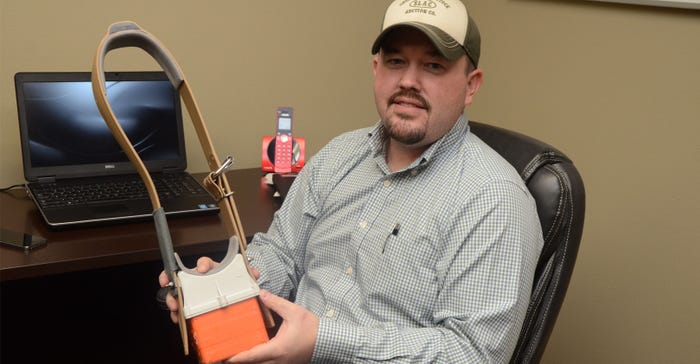
What happens when you mount a GPS tracking device on a cow? As it turns out, a lot of data generation. In fact, in the last three years since he first began tracking cattle behavior and grazing habits using GPS collars, Mitch Stephenson has created Excel sheets with “several hundred thousand rows of data points."
Stephenson, Extension range and forage management specialist at the University of Nebraska's Panhandle Research and Extension Center in Scottsbluff, notes GPS devices have been used to track grazing animals since the late 1990s. He's been doing it at the Panhandle Research and Extension Center, UNL's Gudmundsen Sandhills Laboratory, and UNL's Barta Brothers Ranch since 2015. The key question, Stephenson says, is: How does cattle behavior affect grazing habits?
"We can identify where cattle are selecting to be on a rangeland with these GPS observations and know if they are grazing or resting," he says. "This helps us better understand how a cow's grazing behavior changes as time progresses within a pasture."
The GPS collar, mounted on a cow or calf's neck, links up with a satellite every 10 minutes, giving a reading of where the animal is. With all this data, a map is generated, indicating where cattle are grazing.
Preferential grazing
With two years of data from grazing cow-calf pairs at the Barta Brothers Ranch in the Sandhills of Rock County, Stephenson notes a few things can be taken away. For example, cattle grazing in this environment tend to prefer grass in interdunal swales — the low spots between sand dunes. However, with smaller pastures, the GPS trackers show more uniform grazing distribution.
"Cattle go up into the slopes, too, but they get back into interdune areas more frequently. By making smaller pastures, more water locations, you're usually grazing at higher stocking densities, which usually improves the utilization over a pasture," Stephenson says. "Cattle were more likely to loaf in areas by water or other areas they prefer. It's a multi-faceted thing. It depends on distance to water, slope and topographic position, how difficult is it to get up to an area. There are a lot of factors that come into play."
By controlling these factors, Stephenson notes grazing uniformity can be improved, forage has adequate recovery time, and the landowner can also control the distribution of certain plant species to foster wildlife habitat. Take birds like the mountain plover, for example.
"The mountain plover evolved in areas with heavy, excessive grazing by bison. They like areas of lower vegetation. On the other hand, the Cassin's sparrow likes taller, more dense vegetation. So, it's important to have some grazed areas with short grass structure and some areas with very little grazing," Stephenson says. "You're leaving some areas grazed heavily and some not grazed as well. it's shifting the plant community."
On that same token, GPS trackers can also be used to monitor grazing selectivity of invasive species, and create strategies to manage them. Last year, Stephenson began studying cattle grazing habits in cheatgrass-infested pasture using GPS collars at the Panhandle Research and Extension Center and at the USDA Agricultural Research Service High Plains Grasslands research station near Cheyenne, Wyo.
An invasive annual grass, cheatgrass is actually palatable early on in the growing season. After one year's worth of data, Stephenson notes cattle tended to select for cheatgrass heavily in April and May, but stopped in early June. "Once it goes to seed and matures, cheatgrass drops in palatability. Cheatgrass is an annual, so it puts all its energy into seed development," he says. "The name of the game for control with cheatgrass is limiting the number of seeds that are produced every year."
The challenge, Stephenson notes, is that around the same time, native cool-season grasses like needle-and-thread grass and western wheatgrass are coming out of dormancy. "If we go out too early, are we hitting these perennials too hard?" he asks. "We don't want cattle to overgraze the perennials, but we do want them to really hit the cheatgrass hard."
Potential future uses
Similar technologies to GPS tracking are being used to send alerts to producers when cattle arrive at a water source for a drink, and in some cases, using ear tag devices to set artificial boundaries for cattle — without fencing. However, Stephenson notes, "I still feel this technology is in its infancy. For the most part, it's at the research scale now."
And technology likely won't replace the role of the ranch manager. "Technology probably isn't going to replace that. I hope it doesn't, because there's an art to managing grassland and rangeland, and I don't think technology is ever going to replace that," he says, adding, "It's precision ag. Farmers 50 years ago probably never thought they could press a button and their tractor would drive in perfectly straight rows."
About the Author(s)
You May Also Like






